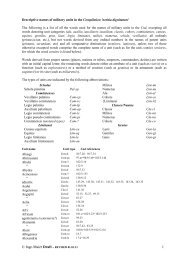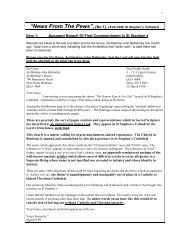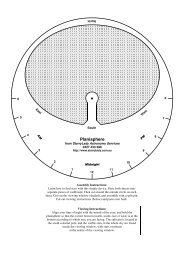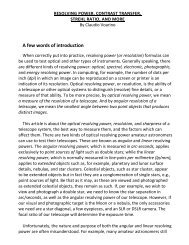The Eurovision Song Contest as a 'Friendship' Network 1
The Eurovision Song Contest as a 'Friendship' Network 1
The Eurovision Song Contest as a 'Friendship' Network 1
Create successful ePaper yourself
Turn your PDF publications into a flip-book with our unique Google optimized e-Paper software.
CONNECTIONS 27(3): 53-58<br />
© 2007 INSNA<br />
http://www.insna.org/Connections-Web/Volume27-3/Dekker.pdf<br />
<strong>The</strong> <strong>Eurovision</strong> <strong>Song</strong> <strong>Contest</strong> <strong>as</strong> a ‘Friendship’ <strong>Network</strong> 1<br />
Anthony Dekker<br />
Australian Defence Science and Technology Organisation (DSTO)<br />
This paper examines the votes c<strong>as</strong>t in the 2005 <strong>Eurovision</strong> <strong>Song</strong> <strong>Contest</strong>. Adjusting votes for song quality, a friendship<br />
network with valued links is obtained. Statistical analysis shows that friendship between countries is largely determined by<br />
geographical proximity, with a visible five-bloc structure. However, large immigrant groups often swayed national ties by<br />
voting for their home country. Some countries, such <strong>as</strong> Switzerland, appear to play a significant bridging role, and the<br />
E<strong>as</strong>tern Mediterranean bloc appears to act <strong>as</strong> a bridge to the new Balkan countries. Analysis thus reveals an emerging<br />
Europe very different from previous network studies of this kind. <strong>The</strong> analysis techniques demonstrated here have more<br />
general applicability, and may be useful for analysing other types of friendship network.<br />
INTRODUCTION<br />
<strong>The</strong> <strong>Eurovision</strong> <strong>Song</strong> <strong>Contest</strong> h<strong>as</strong> been held annually since<br />
1956. Hosted by the European Broadc<strong>as</strong>ting Union, and broadc<strong>as</strong>t<br />
live on television across Europe (with delayed telec<strong>as</strong>ts<br />
internationally), the <strong>Eurovision</strong> <strong>Song</strong> <strong>Contest</strong> seeks to find<br />
Europe’s most popular song. Perhaps the most famous winner<br />
h<strong>as</strong> been Abba, the Swedish entry in 1974, singing “Waterloo.”<br />
On 21 May 2005, the 50th <strong>Eurovision</strong> <strong>Song</strong> <strong>Contest</strong> w<strong>as</strong> held<br />
in Kiev, Ukraine. <strong>The</strong> winning entry out of 24 finalists w<strong>as</strong><br />
from Greece, with Malta <strong>as</strong> the runner-up.<br />
<strong>The</strong> <strong>Eurovision</strong> <strong>Song</strong> <strong>Contest</strong> involves the live television<br />
broadc<strong>as</strong>t of popular songs from various European countries.<br />
Each country then c<strong>as</strong>ts votes for its ten favourites on a 1…12<br />
scale: 12 points for the favorite, 10 for the second favorite, and<br />
8,7,6…1 points in turn for the third to tenth favorite. <strong>The</strong>se<br />
votes are b<strong>as</strong>ed on telephone polls conducted in each country<br />
during the broadc<strong>as</strong>t. Votes c<strong>as</strong>t in the 2005 final are shown in<br />
Table 1, in the format found on the <strong>Eurovision</strong> web site (Euro-<br />
pean Broadc<strong>as</strong>ting Union, 2005). Accusations of political<br />
influence on the voting patterns have been common, particularly<br />
by BBC commentator Terry Wogan (Wikipedia, 2005). A<br />
notable example w<strong>as</strong> the failure of any country to <strong>as</strong>sign points<br />
to the UK in 2003, possibly in protest against UK involvement<br />
in Iraq. Our analysis will confirm that, interpreted using Social<br />
<strong>Network</strong> Analysis techniques, the <strong>Contest</strong> results do indeed<br />
provide a window into European politics.<br />
A difficulty in analysing data from the <strong>Eurovision</strong> <strong>Song</strong> <strong>Contest</strong><br />
h<strong>as</strong> been the enormous variation in the number of participants.<br />
<strong>The</strong> very identity of “Europe” h<strong>as</strong> changed enormously<br />
in the p<strong>as</strong>t 50 years, and the rules of the <strong>Contest</strong> have also<br />
altered. We avoid these issues by using techniques that allow<br />
conclusions to be drawn from a single year’s data, thus presenting<br />
a “snapshot” of a changing Europe at one point in time.<br />
<strong>The</strong> techniques we use may also be of more general interest.<br />
1<br />
Corresponding author: Brian C. Ladd, Department of Mathematics, Computer Science and Statistics, St. Lawrence University, Canton, NY 13617,<br />
phone: 315-229-5293, fax: 315-229-7413, blad@it.stlawu.edu
-54-<br />
Figure 1 shows the average vote in 2005 from country X to<br />
country Y, <strong>as</strong> a function of the total score obtained by country<br />
Y (an indication of the overall popularity of country Y’s entry),<br />
and on the distance between countries X and Y (me<strong>as</strong>ured by<br />
the number of borders needing to be crossed in order to travel<br />
from country X to country Y, thus eliminating geographical<br />
area <strong>as</strong> a factor). Figure 1 shows that the highest votes generally<br />
go to songs whose popularity is shared (i.e. with high total<br />
scores), and to songs from nearby countries (i.e. with small<br />
distances), presumably because of shared linguistic and cultural<br />
factors.<br />
Figure 1. <strong>Eurovision</strong> <strong>Song</strong> <strong>Contest</strong> Votes from Country X to<br />
Country Y <strong>as</strong> a Function of Total Score and Distance Between<br />
Countries<br />
Although the <strong>Eurovision</strong> <strong>Song</strong> <strong>Contest</strong> is ostensibly a competition<br />
on song quality, we can adjust for song quality to obtain a<br />
“friendship” network, similar in structure to friendship networks<br />
between people. <strong>The</strong> resulting social network h<strong>as</strong> valued<br />
links: a high vote for an otherwise unpopular song indicates<br />
maximum friendship, while a low vote for a popular song<br />
indicates le<strong>as</strong>t friendship. We analyse the friendship network<br />
using techniques previously developed for valued networks<br />
(Dekker, 2005), which combine network-analysis methods<br />
with statistical methods. Statistical techniques for Social<br />
<strong>Network</strong> Analysis are also discussed by W<strong>as</strong>serman and Faust<br />
(1994), but the methods they present have limited utility for<br />
valued networks.<br />
Our analysis of the <strong>Eurovision</strong> <strong>Song</strong> <strong>Contest</strong> data reveals a set<br />
of friendship blocs, and a significant tendency to vote for<br />
nearby countries. Some individual countries have more unusual<br />
voting behaviour, and we briefly discuss re<strong>as</strong>ons for this.<br />
Finally, we compare our results with p<strong>as</strong>t studies of the <strong>Eurovision</strong><br />
<strong>Song</strong> <strong>Contest</strong>.<br />
THE FRIENDSHIP NETWORK<br />
We can me<strong>as</strong>ure the quality (or at le<strong>as</strong>t popularity) of country<br />
Y’s song performance by using country Y’s total score SY. This<br />
total provides a me<strong>as</strong>ure of how highly that country’s song w<strong>as</strong><br />
<strong>The</strong> <strong>Eurovision</strong> <strong>Song</strong> <strong>Contest</strong> <strong>as</strong> a ‘Friendship’ <strong>Network</strong> / Dekker<br />
Figure 2. <strong>Eurovision</strong> <strong>Song</strong> <strong>Contest</strong> Votes <strong>as</strong> a Function of Total<br />
Score<br />
rated by a Europe-wide audience. When we plot the vote VXY<br />
from country X to country Y against country Y’s total score SY,<br />
we obtain a weak linear relationship, shown in Figure 2. <strong>The</strong><br />
line of best fit w<strong>as</strong>:<br />
(1)<br />
V ≈ 0. 026 S<br />
XY Y<br />
<strong>The</strong> correlation here is a weak 0.44 (r 2 = 20%), but is statistically<br />
extremely significant (p < 10–44), i.e. votes are indeed<br />
partially determined by the shared perception of song quality,<br />
<strong>as</strong> we would expect. We can therefore adjust scores for song<br />
characteristics by subtracting the predicted vote from the<br />
actual vote, giving a friendship score FXY (we also add 6.1 to<br />
ensure that the result is positive, in the range 0 to 17.4):<br />
FXY = 6.1 + VXY – 0.026 SY (2)<br />
Having subtracted the shared perception of song “quality”<br />
from the votes, the numbers FXY which remain provide an<br />
indication of the bi<strong>as</strong> that country X h<strong>as</strong> towards country Y.<br />
<strong>The</strong>se numbers form a social network with a structure similar<br />
to that obtained by <strong>as</strong>king a group of people how much they<br />
like each other, and we therefore refer to it <strong>as</strong> a friendship<br />
network, in the sense that countries like Norway and Denmark<br />
can be informally described <strong>as</strong> “friends.” However, the bi<strong>as</strong>es<br />
between countries are naturally more complex than friendship<br />
between individuals, being influenced by cultural, political,<br />
and other factors.<br />
Bruine de Bruin (2005) and Haan et al. (2005) have found<br />
that, <strong>as</strong> well <strong>as</strong> song quality, the order of performance also<br />
determines country Y’s total score SY. However, by adjusting<br />
for SY, we are also compensating for that factor.<br />
Figure 3 shows the friendship network, laid out using Spring<br />
Embedding (Freeman, 2000), a process equivalent to Multidimensional<br />
Scaling (Brandes, 2001). For clarity, Figure 3 shows<br />
only arrows corresponding to votes with a high friendship score<br />
FXY > 12. In this network, friendship tends not to be returned:<br />
the correlation between FXY and its inverse FYX is a
Figure 3. <strong>Eurovision</strong> <strong>Song</strong> <strong>Contest</strong> Friendship <strong>Network</strong><br />
weak 0.40 (we will discuss the re<strong>as</strong>ons for this later in the<br />
returned: the correlation between FXY and its inverse FYX is<br />
a weak 0.40 (we will discuss the re<strong>as</strong>ons for this later in the<br />
paper). In our experience, a correlation of 0.6 or more<br />
would indicate a symmetric relationship (Dekker, 2005).<br />
A consequence of the lack of symmetry in friendship is<br />
that the concept of link distance between people which<br />
we introduced in previous work (Dekker, 2005) must be<br />
used with caution, since it is b<strong>as</strong>ed on symmetrical relationships.<br />
Figure 3 should therefore be interpreted with<br />
care, particularly since the correlation between friendship<br />
scores FXY and distances in the diagram is a relatively<br />
weak –0.38.<br />
Conclusions about individual countries from distances in<br />
Figure 3 should be made with care. However, Figure 3<br />
does contain several visually apparent friendship blocs,<br />
composed of nearby countries which vote for each other.<br />
Figure 4 shows more clearly these friendship blocs, which<br />
are:<br />
• E<strong>as</strong>tern: former USSR, Romania, Hungary, Poland.<br />
• Nordic: Norway, Sweden, Denmark, Finland, Iceland.<br />
• Balkan: former Yugoslavia, Albania.<br />
• E<strong>as</strong>tern Mediterranean: Greece, Cyprus, Malta, Bulgaria,<br />
Turkey.<br />
• Western: other countries.<br />
We also grouped countries computationally, by considering<br />
only votes with a high friendship score FXY > 12,<br />
and applying the Strongly Connected Components algo-<br />
<strong>The</strong> <strong>Eurovision</strong> <strong>Song</strong> <strong>Contest</strong> <strong>as</strong> a ‘Friendship’ <strong>Network</strong> / Dekker -55-<br />
rithm (Gibbons, 1985). This algorithm h<strong>as</strong> the advantage<br />
of being fully deterministic, and finds three clusters in this<br />
c<strong>as</strong>e. <strong>The</strong>y are subsets of the E<strong>as</strong>tern bloc (Russia, Latvia,<br />
Moldova, Ukraine), Nordic bloc (Norway, Sweden, Denmark),<br />
and Balkan and E<strong>as</strong>tern Mediterranean blocs<br />
together (Greece, Cyprus, Albania, and former Yugoslavia).<br />
<strong>The</strong> Strongly Connected Components algorithm<br />
groups Malta with the E<strong>as</strong>tern bloc because its secondhighest<br />
vote w<strong>as</strong> for Latvia, while Malta received Russia’s<br />
highest vote. However, it seems more appropriate to<br />
define the E<strong>as</strong>tern bloc <strong>as</strong> the former Warsaw Pact countries<br />
(with the exception of Bulgaria, which gave its highest<br />
votes to Greece and Cyprus, and is therefore grouped<br />
with them). It also seems appropriate to separate the<br />
Balkan and E<strong>as</strong>tern Mediterranean blocs, which are visibly<br />
distinct in Figure 3.<br />
Grouping countries using a Simulated Annealing algorithm<br />
(Hecht-Nielsen, 1990) gives different results each<br />
time the algorithm is run, but consistently separates the<br />
Balkan and E<strong>as</strong>tern Mediterranean blocs, while giving<br />
inconsistent groupings for the other countries. This supports<br />
our separation of the Balkan and E<strong>as</strong>tern Mediterranean<br />
blocs.<br />
Another common way of grouping countries is the use of<br />
taxonomic trees, <strong>as</strong> in Fenn at al. (2005). However, taxonomic<br />
trees are known to be sensitive to random noise in the<br />
data. We applied a taxonomic algorithm which randomly alters<br />
all friendship scores by between 0 and 0.1%, calculates taxonomic<br />
trees using neighbour-joining (Pachter and Sturmfels,<br />
Figure 4. Friendship Blocs in the <strong>Eurovision</strong> <strong>Song</strong> <strong>Contest</strong>
-56-<br />
Figure 5. Common<br />
Relationships in Taxonomic<br />
Trees for<br />
Countries<br />
Figure 6. Links Between Friendship Blocs in the<br />
<strong>Eurovision</strong> <strong>Song</strong> <strong>Contest</strong><br />
<strong>The</strong> <strong>Eurovision</strong> <strong>Song</strong> <strong>Contest</strong> <strong>as</strong> a ‘Friendship’ <strong>Network</strong> / Dekker<br />
2005), repeats this 100 times, and then<br />
takes only the relationships common<br />
to all 100 trees. <strong>The</strong>re were very few of<br />
such common relationships, underscoring<br />
the brittleness of taxonomictree<br />
formation. Tree relationships<br />
which were not common, i.e. which<br />
altered in the face of only a 0.1% alteration<br />
in the data, are clearly due to<br />
chance, and therefore meaningless.<br />
Figure 5 shows the common relationships.<br />
<strong>The</strong> only cluster recognisable in<br />
this diagram is the E<strong>as</strong>tern bloc, not<br />
including Hungary and Romania<br />
(which are closer to the Western bloc)<br />
or Estonia (which is closer to the<br />
Nordic bloc).<br />
As would be expected, friendship<br />
scores within a bloc were higher than<br />
between blocs (on average, 8.1 versus<br />
5.6, significant at p < 10 –20 ). Table 2<br />
shows the average friendship scores<br />
between and within blocs. Interestingly,<br />
the Western bloc w<strong>as</strong> the le<strong>as</strong>t<br />
cohesive: within-bloc scores were lowest<br />
for the Western bloc.<br />
Figure 6 shows the above-average between-bloc scores. <strong>The</strong><br />
pairs Balkan/E<strong>as</strong>tern Mediterranean, Western/E<strong>as</strong>tern, Western/Nordic,<br />
and Western/E<strong>as</strong>tern Mediterranean had aboveaverage<br />
scores in both directions, and there w<strong>as</strong> also a triangle<br />
of unidirectional above-average scores. Figure 6 highlights the<br />
position of the Balkan countries <strong>as</strong> “new arrivals” in Europe,<br />
and a possible “bridging” role played by the E<strong>as</strong>tern Mediterranean<br />
countries. Individual Western countries such <strong>as</strong> Austria<br />
and Switzerland may also play a “bridging” role. <strong>The</strong> links<br />
between the Western bloc and the other blocs reflects the p<strong>as</strong>t<br />
dominance of Europe (and the <strong>Eurovision</strong> <strong>Song</strong> <strong>Contest</strong>) by<br />
the Western bloc.<br />
Table 2. Average Friendship Scores Within and Between Blocs<br />
To<br />
E<strong>as</strong>tern Nordic Balkan E<strong>as</strong>tMed Western<br />
E<strong>as</strong>tern 7.9 6.1 5.0 4.4 6.5<br />
Nordic 5.3 11.3 4.8 5.9 6.0<br />
Balkan 4.9 4.5 11.0 5.8 5.0<br />
E<strong>as</strong>tMed 6.2 4.7 6.0 8.7 5.8<br />
Western 5.7 5.8 5.5 6.8 6.6<br />
From<br />
Austria and Switzerland are somewhat exceptional countries.<br />
Both gave strong votes to Balkan countries, presumably because<br />
of large numbers of Balkan immigrants (Switzerland also received<br />
strong votes from Finland and the E<strong>as</strong>tern bloc). Similarly,<br />
Romanian immigrants in Spain seem to have given strong<br />
votes to their home country, <strong>as</strong> did Turkish immigrants in the<br />
five countries with the most Turkish immigrants: Belgium,<br />
France, Germany, Austria, and the Netherlands (Manço,<br />
2004). This kind of voting w<strong>as</strong> in general not returned. Table 3<br />
lists the fifteen greatest <strong>as</strong>ymmetries in friendship scores, where<br />
the score F XY w<strong>as</strong> 7 or more points greater than the reverse<br />
score F YX. Of these, six can be tentatively attributed to immigrants<br />
(Niessen et al., 2005). However, this attribution cannot,<br />
of course, be confirmed without surveying <strong>Eurovision</strong> voters on<br />
the re<strong>as</strong>ons for their vote.<br />
Table 3. Fifteen Greatest Asymmetries in Friendship Scores<br />
Between Countries<br />
Country Pair<br />
Friendship<br />
Score<br />
Reverse<br />
Score<br />
Possible<br />
Re<strong>as</strong>on<br />
Latvia Switzerland 14.7 2.1 ?<br />
Switzerland Albania 14.7 2.7 ?<br />
Serbia/<br />
Immigrants<br />
Switzerland Montenegro 14.5 2.7<br />
Malta Cyprus 16.9 7 ?<br />
France Turkey 15.7 5.8 Immigrants<br />
Denmark Turkey 11.7 2.8 Immigrants<br />
Spain Romania 13.9 5.4 Immigrants<br />
Russia Malta 13 4.6 ?<br />
Turkey Greece 12 3.7 ?<br />
Moldova Sweden 10.3 2.2 ?<br />
Germany Turkey 13.7 6 Immigrants<br />
Latvia Russia 14.6 7.1 Former USSR<br />
Spain Denmark 12.8 5.4 ?<br />
Albania Cyprus 11.9 4.7 ?<br />
Switzerland Turkey 9.7 2.7 Immigrants<br />
THE EFFECT OF DISTANCE<br />
Although we are not able to use the concept of link distance<br />
(Dekker, 2005) for analysis, we can use related statistical<br />
techniques to examine the factors that determine friendship<br />
scores. A good predictor of the friendship score FXY w<strong>as</strong> the
distance DXY between countries which we discussed above<br />
(me<strong>as</strong>ured by the number of borders needing to be crossed in<br />
order to travel from country X to country Y). This is presumably<br />
because of cultural and linguistic factors shared between<br />
nearby countries. Economic factors (<strong>as</strong> me<strong>as</strong>ured by differences<br />
between country’s GDPs) did not seem to have an effect, nor<br />
did population size. Linguistic difference alone (<strong>as</strong> me<strong>as</strong>ured by<br />
distance in a four-level language family tree) had a small effect<br />
(r 2 = 2%), but this effect vanished when DXY w<strong>as</strong> included,<br />
since DXY already incorporates cultural and linguistic factors.<br />
<strong>The</strong> line of best fit w<strong>as</strong>:<br />
FXY ≈ 7.8 – 0.46 DXY (3)<br />
<strong>The</strong> correlation here w<strong>as</strong> a very weak –0.24 (r2 = 6%), but<br />
w<strong>as</strong> statistically extremely significant (p < 10–12), thus providing<br />
additional justification for defining blocs of countries<br />
which are geographically close to each other. Figure 7 shows<br />
the relationship graphically. An alternative way of describing<br />
the result is that the original vote VXY from country X to<br />
country Y (see Figure 1) can be explained (by analysis of variance)<br />
<strong>as</strong> 20% due to country Y’s total score SY, 4% due to the<br />
distance DXY between countries, and 76% due to other factors.<br />
We would expect some of the 76% to be explained by the<br />
numbers of immigrants from country Y living in country X, but<br />
accurate statistics on this are difficult to obtain.<br />
Figure 7. Friendship Scores <strong>as</strong> a Function of Distance<br />
between Countries<br />
CENTRALITY<br />
Various forms of centrality concept have shown great utility in<br />
Social <strong>Network</strong> Analysis (W<strong>as</strong>serman and Faust, 1994). We<br />
therefore calculated valued centrality (Dekker, 2005) scores<br />
for each of the countries in Figure 3. This centrality me<strong>as</strong>ure<br />
takes “closeness” to be the inverse of distances dij along network<br />
paths, and obtains valued centrality Ci by averaging<br />
closeness values:<br />
1<br />
C =<br />
n 1<br />
<strong>The</strong> <strong>Eurovision</strong> <strong>Song</strong> <strong>Contest</strong> <strong>as</strong> a ‘Friendship’ <strong>Network</strong> / Dekker -57-<br />
∑<br />
d<br />
i ij<br />
− j≠i (4)<br />
This is the most suitable definition of centrality for valued<br />
networks (Dekker, 2005). However, since me<strong>as</strong>uring distance<br />
along network paths is not really appropriate with non-symmetric<br />
friendship relationships, the valued centrality scores<br />
should be interpreted with some caution. <strong>The</strong>re w<strong>as</strong> a strong<br />
correlation of 0.84 between valued centrality scores and total<br />
<strong>Contest</strong> scores (r2 = 70%, significant at p < 10–6), <strong>as</strong> shown<br />
in Figure 8.<br />
Figure 8. Valued Centrality Scores <strong>as</strong> a Function of Total<br />
<strong>Contest</strong> Score<br />
Of particular interest are the countries whose valued centrality<br />
is higher than their total score would indicate, in particular<br />
Turkey and Switzerland. This seems to reflect the high votes<br />
which Turkey obtained from Turkish immigrants in Western<br />
countries, and “neutral” Switzerland acting <strong>as</strong> a “bridge” between<br />
blocs by giving votes to the Balkans while receiving<br />
them from the E<strong>as</strong>tern bloc.<br />
DISCUSSION<br />
By adjusting <strong>Eurovision</strong> <strong>Song</strong> <strong>Contest</strong> votes to compensate for<br />
song quality, we have obtained a friendship network which can<br />
indeed “reveal by homology the structure of political Europe”<br />
(le Guern, 2002). <strong>The</strong> structure that our analysis h<strong>as</strong> revealed<br />
is very different from that reported by Yair (1995), who partially<br />
compensated for song quality by averaging votes over<br />
several years. Yair’s study revealed the Western bloc <strong>as</strong> dominant.<br />
In contr<strong>as</strong>t, today’s Europe is very different, with Western<br />
countries being le<strong>as</strong>t central and le<strong>as</strong>t cohesive, and Central<br />
Europe being more important.<br />
In general, we found that friendship scores were highest for<br />
nearby countries, resulting in five friendship blocs: Western,<br />
E<strong>as</strong>tern, Nordic, Balkan, and E<strong>as</strong>tern Mediterranean. <strong>The</strong> new<br />
countries of the Balkans were most isolated, with the E<strong>as</strong>tern<br />
Mediterranean countries, Austria, and Switzerland acting <strong>as</strong><br />
“bridges.” <strong>The</strong> p<strong>as</strong>t dominance of the Western bloc is reflected<br />
in its close ties to the other blocs (excluding the Balkans).
-58-<br />
Recent work by Fenn et al. (2005) examines <strong>Eurovision</strong> <strong>Song</strong><br />
<strong>Contest</strong> data from the period 1992–2003, using the framework<br />
of complex dynamical networks, and also averaging votes over<br />
several years. For the smaller set of countries competing in that<br />
period, they also found regional clustering, particularly the pair<br />
Greece/Cyprus, the Nordic bloc (including Estonia), and the<br />
Western bloc, which (unlike Yair) they did not find to be<br />
cohesive. However, this analysis w<strong>as</strong> b<strong>as</strong>ed on taxonomic trees,<br />
which may be deceptive. Fenn et al. also found UK voting to<br />
be consistently the most in tune with the rest of Europe—and<br />
indeed, in 2005, the UK w<strong>as</strong> the only country which gave its<br />
top two votes to the ultimate winner (Greece) and runner-up<br />
(Malta). This may be a result of the UK’s reduced involvement<br />
in regional ties and/or conflicts.<br />
DISCUSSION<br />
By adjusting <strong>Eurovision</strong> <strong>Song</strong> <strong>Contest</strong> votes to compensate for<br />
song quality, we have obtained a friendship network which can<br />
indeed “reveal by homology the structure of political Europe”<br />
(le Guern, 2002). <strong>The</strong> structure that our analysis h<strong>as</strong> revealed<br />
is very different from that reported by Yair (1995), who partially<br />
compensated for song quality by averaging votes over<br />
several years. Yair’s study revealed the Western bloc <strong>as</strong> dominant.<br />
In contr<strong>as</strong>t, today’s Europe is very different, with Western<br />
countries being le<strong>as</strong>t central and le<strong>as</strong>t cohesive, and Central<br />
Europe being more important.<br />
In general, we found that friendship scores were highest for<br />
nearby countries, resulting in five friendship blocs: Western,<br />
E<strong>as</strong>tern, Nordic, Balkan, and E<strong>as</strong>tern Mediterranean. <strong>The</strong> new<br />
countries of the Balkans were most isolated, with the E<strong>as</strong>tern<br />
Mediterranean countries, Austria, and Switzerland acting <strong>as</strong><br />
“bridges.” <strong>The</strong> p<strong>as</strong>t dominance of the Western bloc is reflected<br />
in its close ties to the other blocs (excluding the Balkans).<br />
Recent work by Fenn et al. (2005) examines <strong>Eurovision</strong> <strong>Song</strong><br />
<strong>Contest</strong> data from the period 1992–2003, using the framework<br />
of complex dynamical networks, and also averaging votes over<br />
several years. For the smaller set of countries competing in that<br />
period, they also found regional clustering, particularly the pair<br />
Greece/Cyprus, the Nordic bloc (including Estonia), and the<br />
Western bloc, which (unlike Yair) they did not find to be<br />
cohesive. However, this analysis w<strong>as</strong> b<strong>as</strong>ed on taxonomic trees,<br />
which may be deceptive. Fenn et al. also found UK voting to<br />
be consistently the most in tune with the rest of Europe—and<br />
indeed, in 2005, the UK w<strong>as</strong> the only country which gave its<br />
top two votes to the ultimate winner (Greece) and runner-up<br />
(Malta). This may be a result of the UK’s reduced involvement<br />
in regional ties and/or conflicts.<br />
Gatherer (2006) examines data in five-year windows over<br />
several years (1975–2005), comparing them against simulation<br />
results, which allows him to perform tests of statistical significance<br />
on links. He finds two large clusters in the period from<br />
2001 to 2005: a “Balkan Bloc,” which includes our E<strong>as</strong>tern<br />
Mediterranean cluster, and a “Viking Empire,” of the Nordic<br />
<strong>The</strong> <strong>Eurovision</strong> <strong>Song</strong> <strong>Contest</strong> <strong>as</strong> a ‘Friendship’ <strong>Network</strong> / Dekker<br />
countries with Latvia, Lithuania, and Estonia. However, his<br />
analysis does not allow relationships outside these clusters, or<br />
relationships between clusters, to be inferred. In addition, this<br />
and other previous studies do not adequately eliminate song<br />
quality <strong>as</strong> a factor, and therefore potentially obscure the true<br />
bi<strong>as</strong> or friendship relationships between countries.<br />
<strong>The</strong> high valued centrality score for Turkey in our study<br />
emph<strong>as</strong>ises the importance of immigrants from one country<br />
living in another. Van der Veen (2002) points out that such<br />
expatriate workers are also of importance in the formation of a<br />
pan-European social identity. <strong>The</strong> high valued centrality score<br />
for Switzerland suggests that it plays a “bridging” role within<br />
the new Europe, although the re<strong>as</strong>ons for this are not completely<br />
clear.<br />
Just <strong>as</strong> the mathematical techniques we have presented have<br />
illuminated the structure of Europe, they can also be used to<br />
generate friendship networks from other competitions where<br />
the participants (or their representatives) double <strong>as</strong> the voting<br />
jury. For example, in the judging of the Olympic Games, the<br />
difference between individual judge’s scores and the average<br />
for a particular performance can be used <strong>as</strong> a friendship vote<br />
from the judge’s country to the athlete’s. Unlike previous<br />
techniques for studying the <strong>Eurovision</strong> <strong>Song</strong> <strong>Contest</strong>, the<br />
method we describe does not require many years of historical<br />
data, and hence can be used for studying social structures<br />
which are in a state of flux. <strong>The</strong> analysis techniques presented<br />
in this paper can also be used for analysing other friendship<br />
networks, <strong>as</strong> well <strong>as</strong> trust networks, which have a similar structure.
Votes From<br />
<strong>The</strong> <strong>Eurovision</strong> <strong>Song</strong> <strong>Contest</strong> <strong>as</strong> a ‘Friendship’ <strong>Network</strong> / Dekker -59-<br />
Table 1. Votes C<strong>as</strong>t for <strong>Eurovision</strong> <strong>Song</strong> <strong>Contest</strong> Final in 2005<br />
Greece<br />
Malta<br />
Romania<br />
Israel<br />
Latvia<br />
Moldova<br />
SerbiaMont<br />
Switzerland<br />
Norway<br />
Denmark<br />
Votes To<br />
Croatia<br />
Hungary<br />
Turkey<br />
BosniaHerz<br />
Russia<br />
Albania<br />
FYRM<br />
Cyprus<br />
Sweden<br />
Ukraine<br />
Spain<br />
UK<br />
France<br />
Germany<br />
Total Score<br />
Andorra 4 0 7 8 10 0 0 1 2 3 0 6 0 0 0 0 0 0 0 0 12 0 5 0<br />
Albania 12 4 5 3 0 0 6 0 0 0 2 0 8 0 0 — 10 7 0 0 0 0 1 0<br />
Austria 4 5 6 1 0 2 12 0 0 0 8 0 7 10 0 3 0 0 0 0 0 0 0 0<br />
Belarus 0 5 1 8 6 7 3 10 4 0 0 2 0 0 12 0 0 0 0 0 0 0 0 0<br />
Belgium 12 8 7 6 5 1 0 0 3 4 0 2 10 0 0 0 0 0 0 0 0 0 0 0<br />
BosniaHerz 6 0 2 0 0 4 10 0 3 0 12 1 8 — 0 5 7 0 0 0 0 0 0 0<br />
Bulgaria 12 0 8 0 0 6 4 0 1 0 2 5 3 0 0 0 7 10 0 0 0 0 0 0<br />
Croatia 5 4 0 0 7 1 12 3 0 0 — 6 0 10 0 2 8 0 0 0 0 0 0 0<br />
Cyprus 12 6 8 0 1 2 10 4 3 0 0 7 0 0 0 0 0 — 0 0 0 5 0 0<br />
Denmark 2 10 3 5 6 0 0 1 12 — 0 0 8 4 0 0 0 0 7 0 0 0 0 0<br />
Estonia 0 4 0 1 10 6 0 12 8 5 2 3 0 0 7 0 0 0 0 0 0 0 0 0<br />
Finland 3 8 0 5 4 0 0 10 12 2 1 0 0 0 7 0 0 0 6 0 0 0 0 0<br />
France 8 7 5 10 0 2 6 0 0 0 0 3 12 0 0 1 0 0 0 0 4 0 — 0<br />
FYRM 7 0 2 0 0 5 10 0 0 0 8 1 4 3 0 12 — 0 6 0 0 0 0 0<br />
Germany 12 8 0 5 7 1 3 4 0 6 2 0 10 0 0 0 0 0 0 0 0 0 0 —<br />
Greece — 8 5 0 1 7 6 3 4 0 0 2 0 0 0 10 0 12 0 0 0 0 0 0<br />
Hungary 12 5 10 8 1 4 2 3 0 6 7 — 0 0 0 0 0 0 0 0 0 0 0 0<br />
Iceland 2 4 5 0 3 8 0 7 12 10 1 6 0 0 0 0 0 0 0 0 0 0 0 0<br />
Ireland 2 10 5 6 12 0 0 3 4 7 0 0 0 1 0 0 0 0 0 0 0 8 0 0<br />
Israel 7 10 12 — 6 4 0 2 1 3 0 8 0 0 0 0 0 0 0 0 0 0 5 0<br />
Latvia 0 5 0 2 — 8 1 12 6 4 7 3 0 0 10 0 0 0 0 0 0 0 0 0<br />
Lithuania 1 2 0 3 12 10 0 8 5 4 6 0 0 0 7 0 0 0 0 0 0 0 0 0<br />
Malta 6 — 7 8 10 2 0 1 5 3 0 0 0 0 0 0 0 12 0 0 0 4 0 0<br />
Moldova 4 0 7 6 12 — 1 0 3 0 0 0 0 0 10 0 0 0 5 8 0 0 0 2<br />
Monaco 0 5 4 12 0 0 6 8 0 10 7 0 0 0 0 0 1 0 3 0 0 0 0 2<br />
Netherlands 10 5 3 7 0 0 4 0 1 8 2 0 12 6 0 0 0 0 0 0 0 0 0 0<br />
Norway 4 10 6 5 8 0 0 3 — 12 2 0 0 7 0 0 0 0 1 0 0 0 0 0<br />
Poland 1 0 7 0 4 3 0 6 8 5 2 10 0 0 0 0 0 0 0 12 0 0 0 0<br />
Portugal 3 0 12 5 6 10 0 4 0 1 0 2 0 0 0 0 0 0 0 7 8 0 0 0<br />
Romania 10 2 — 7 0 12 6 0 0 4 5 8 3 0 0 0 0 1 0 0 0 0 0 0<br />
Russia 4 12 0 8 5 10 6 7 0 0 1 3 0 0 — 0 0 0 0 2 0 0 0 0<br />
SerbiaMont 12 0 3 0 0 5 — 0 2 0 10 6 0 4 0 8 7 1 0 0 0 0 0 0<br />
Slovenia 2 1 0 0 7 3 10 6 4 0 12 0 0 8 0 0 5 0 0 0 0 0 0 0<br />
Spain 8 7 12 6 0 4 0 0 3 10 0 5 0 0 0 0 0 0 2 1 — 0 0 0<br />
Sweden 12 6 2 1 3 0 4 5 8 10 0 0 0 7 0 0 0 0 — 0 0 0 0 0<br />
Switzerland 7 3 0 1 0 0 12 — 0 0 8 0 6 5 0 10 2 0 0 0 4 0 0 0<br />
Turkey 12 8 4 3 0 7 0 0 0 0 0 6 — 10 0 2 5 0 0 0 0 1 0 0<br />
Ukraine 0 10 0 7 1 12 3 5 6 0 8 2 0 0 4 0 0 0 0 — 0 0 0 0<br />
UK 12 10 0 7 6 2 0 0 5 8 0 0 1 4 0 0 0 3 0 0 0 — 0 0<br />
230<br />
192<br />
158<br />
154<br />
153<br />
148<br />
137<br />
128<br />
125<br />
125<br />
115<br />
97<br />
92<br />
79<br />
57<br />
53<br />
52<br />
46<br />
30<br />
30<br />
28<br />
18<br />
11<br />
4
-60-<br />
REFERENCES<br />
Brandes, U. (2001). Drawing on Physical Analogies. In<br />
Drawing Graphs: Methods and Models (Michael Kaufmann<br />
and Dorothea Wagner, eds), Springer-Verlag Lecture Notes<br />
in Computer Science 2025: 71–86.<br />
Bruine de Bruin, W. (2005). Save the l<strong>as</strong>t dance for me:<br />
unwanted serial position effects in jury evaluations. Acta<br />
Psychologica 118: 245–260.<br />
Dekker, A.H. (2005). Conceptual Distance in Social <strong>Network</strong><br />
Analysis. Journal of Social Structure, 6 (3):<br />
www.cmu.edu/joss/content/articles/volume6/dekker/<br />
European Broadc<strong>as</strong>ting Union, (2005). <strong>Eurovision</strong> <strong>Song</strong><br />
<strong>Contest</strong> web site, accessed 10 June 2005:<br />
www.eurovision.tv<br />
Fenn, D., Suleman, O., Efstathiou, J., and Johnson, N.F.<br />
(2005). How does Europe Make Its Mind Up?<br />
Connections, cliques, and compatibility between<br />
countries in the <strong>Eurovision</strong> <strong>Song</strong> <strong>Contest</strong>. Oxford: Oxford<br />
University: arxiv.org/abs/physics/0505071<br />
Freeman, L.C. (2000). Visualizing Social <strong>Network</strong>s. Journal of<br />
Social Structure, 1(1): www.cmu.edu/joss/content/articles/<br />
volume1/Freeman.html<br />
Gatherer, D. (2006). Comparison of <strong>Eurovision</strong> <strong>Song</strong> <strong>Contest</strong><br />
Simulation with Actual Results Reveals Shifting Patterns<br />
of Collusive Voting Alliances. Journal of Artificial Societies<br />
and Social Simulation, 9(2):<br />
j<strong>as</strong>ss.soc.surrey.ac.uk/9/2/1.html<br />
Gibbons, A. (1985). Algorithmic Graph <strong>The</strong>ory. Cambridge:<br />
Cambridge University Press.<br />
Haan, M., Dijkstra, S., and Dijkstra, P. (2005). Expert<br />
Judgment Versus Public Opinion – Evidence from the<br />
<strong>Eurovision</strong> <strong>Song</strong> <strong>Contest</strong>. Journal of Cultural Economics<br />
29: 59–78.<br />
Hecht-Nielsen, R. (1990). Neurocomputing. Reading,<br />
M<strong>as</strong>sachusetts: Addison Wesley.<br />
Niessen, J., Schibel, Y., and Thompson, C. (eds.), (2005).<br />
Current Immigration Debates in Europe. Brussels:<br />
Migration Policy Group:<br />
www.migpolgroup.com/documents/3055.html<br />
le Guern, P. (2002). From National Pride to Global Kitsch: the<br />
<strong>Eurovision</strong> <strong>Song</strong> <strong>Contest</strong>. Lille: University of Lille:<br />
wjfms.ncl.ac.uk/leguWJ.htm<br />
<strong>The</strong> <strong>Eurovision</strong> <strong>Song</strong> <strong>Contest</strong> <strong>as</strong> a ‘Friendship’ <strong>Network</strong> / Dekker<br />
Manço, U. (2004). Turks in Western Europe. Brussels: Centre<br />
d’Etudes Sociologiques, Facultes Universitaires Saint-<br />
Louis: www.flwi.ugent.be/cie/umanco/umanco3.htm<br />
Pachter, L. and Sturmfels, B. (2005). Algebraic Statistics for<br />
Computational Biology. Cambridge: Cambridge University<br />
Press.<br />
van der Veen, A.M. (2002). Determinants and Implications of<br />
European Identity: An Investigation Using Eurobarometer<br />
Data. Philadelphia, PA: University of Pennsylvania:<br />
www.ssc.upenn.edu/~maurits/papers/EUsupport.doc<br />
W<strong>as</strong>serman, S. and Faust, K. (1994). Social <strong>Network</strong> Analysis:<br />
Methods and Applications. Cambridge: Cambridge<br />
University Press.<br />
Wikipedia, (2005). <strong>Eurovision</strong> <strong>Song</strong> <strong>Contest</strong>, accessed 10 June<br />
2005: en.wikipedia.org/wiki/<strong>Eurovision</strong>_<strong>Song</strong>_<strong>Contest</strong><br />
Yair, G. (1995). ‘Unite Unite Europe’ <strong>The</strong> political and<br />
cultural structures of Europe <strong>as</strong> reflected in the <strong>Eurovision</strong><br />
<strong>Song</strong> <strong>Contest</strong>. Social <strong>Network</strong>s, 17(2): 147–161.
















